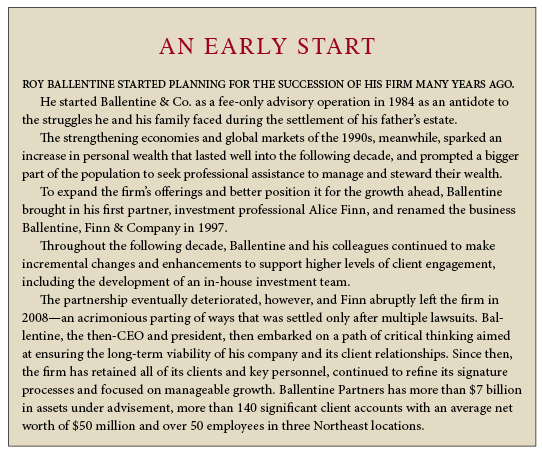Grove: You’ve all mentioned learning, knowledge transfer, continuity and skills, much of which is dependent on a strong internal culture and curriculum. Let’s talk training.
Ballentine: We’ve been in business a long time; we’ve got decades of experience and expertise. We have an obligation to document it, make it learnable and help others acquire it. I also believe in having clearly stated values and a code of ethics. Everyone must have the same priorities if we are going to work together effectively as a team [see sidebar].
Edwards-Pitt: As a result, we have an extensive internal training curriculum, especially around values which are key to how we operate, but also on financial basics, income tax planning and similar technical topics.
Grove: Any interesting stories or “aha” moments?
McMorrow: We learned quickly that there was very little information available on how to manage mistakes. Most examples were situations to avoid, so Roy looked at the medical field where hospitals tended to have one of two policies regarding mistakes: confess or cover it up. We wanted to use mistakes as a chance to learn.
Grove: That’s a unique approach in an industry where small mistakes can often add up to serious dollars.
McMorrow: It’s all part of the process of making incremental improvements. The more we can learn from our missteps, the more likely it is we can avoid those same missteps in the future. In-the-moment teaching opportunities are very powerful.
Grove: Covie, the wealth advisory group is a new initiative under your leadership. Can you tell us about it?
Edwards-Pitt: We’ve always had a function to provide strategic advice on the non-investment aspects of wealth management. Now, it’s a group of 25 people that lead client engagements and all that entails. We are involved in things that range from staffing requirements and morale to career progression advice to reporting, delivery and thought leadership and generally staying at the forefront of the industry. Getting everyone’s participation in the process was critical to bringing focus and specialization to our roles and helping employees move from the mind-set of being a sole proprietor to a partner.
Grove: Perhaps the most important part of your role is engaging regularly with clients. What can you tell our readers about your client base?
Edwards-Pitt: The firm’s clients have an average net worth of close to $50 million, ranging as high as $1 billion. Most have the kinds of complex interests and needs that require professional assistance and some oversight of their entire balance sheets, not just their liquid assets. Many of them are entrepreneurial in nature, with a whole or partial stake in an operating company, direct investments in other ventures and highly illiquid balance sheets.
Grove: Business owners can present unique challenges to advisors, especially when business and personal issues collide.
Edwards-Pitt: Yes, they can, and in those situations we try to get involved and add value where possible. Ballentine Partners has helped its business-owner clients do things as diverse as restructure a company and change dividend policies to minimize tax implications.

Grove: I understand that you have a number of professional investors as clients too. How does that work?
Edwards-Pitt: Yes, many of our clients have amassed fortunes in the investment field and now are focused on stabilizing, diversifying and protecting their assets, all of which requires us to be extremely confident when engaging with them, making recommendations and challenging ideas.
Grove: Is there a pattern to when you begin working with clients?
Edwards-Pitt: It tends to be around trigger events such as liquidity, death or divorce. People are aware that their financial situation and responsibility are changing radically and they seek involvement from an objective third party.
Grove: How do you interface with clients?
Edwards-Pitt: Every client relationship is assigned a team that is comprised of five key functions: a senior client advisor, a financial planner, a senior investment advisor, a portfolio manager and an analyst. We always lead with planning, an effort that is particularly strong due to our people and the up-front focus. Not all clients want to be involved to the same degree; others simply want to hire an expert and trust us to do our job. We accommodate all kinds of approaches.
Grove: Do you have any guidelines to ensure that those interactions are high-impact?
Edwards-Pitt: We track nine keys areas for all of our clients, including their balance sheet, investments, cash flow and income taxes, estate planning, risk management and insurance, philanthropy, legacy, the wealth management process and any privately owned business interests. We discuss a range of topics and always try to help them tackle at least one big issue at every meeting.








